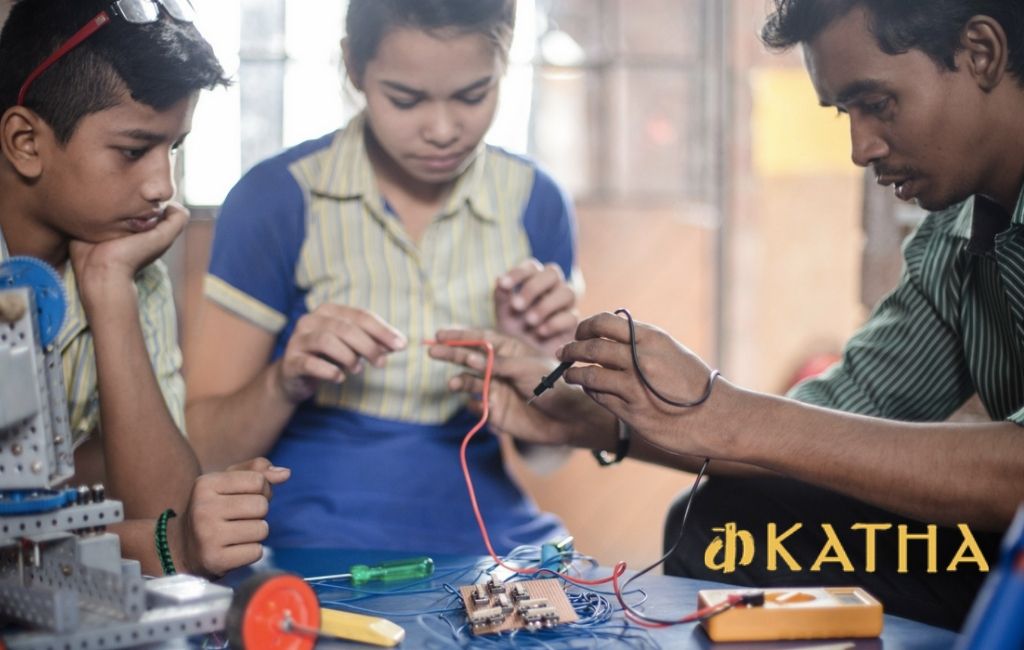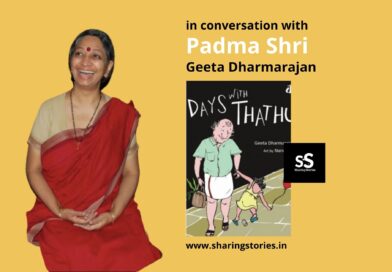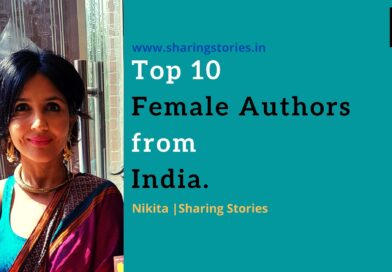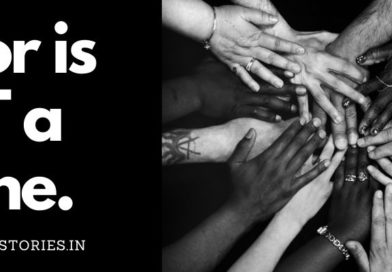Padma Shri Geeta Dharmarajan
In Conversation with Geeta Dharmarajan
Katha Org
How did the whole idea of Katha evolve?
I will have to go back to my childhood to answer your question. The whole idea and practice of storytelling, going to the temple with my thatha (Grandfather), listening to stories there, and discussing the same on the way back. It was a blissful childhood filled with stories. Kamalam Mami used to tell us a lot of ghost stories. I was deliciously frightened by her stories. These have been very much a part of my upbringing; stories, which unfolded a deeper meaning to me. Stories made me think and ask questions. I saw this as a process of growing up. This was the reason that at one point of time I began to question Rama the god and his whole sense of ethics or kindness.
During my working days at the University of Pennsylvania, USA, in the early 1980s, I discovered India all over again! I saw their bookstores and the Van Pelt Library filled with translations from Spanish, Russian, Italian, even Tamil! A literary agent, Mrs. Markinko, in NY, said she loved my writings. She wanted to represent me and asked me to send her some of my stories.
But there was a great nostalgic feeling of “wanting to return” and after two years, my family and I returned to India. I wanted to explore the field of literary translation between the Indian bhashas. Stories and literature have the power to bring people together, people can understand one another better if they are linked through each other’s stories and literature. Translations of quality empathetic writing can be, and is non-divisive. I enjoyed writing children’s stories. I wanted to introduce our children to the rich storehouse of literature from more than 3000 years of Indian literary traditions. Within a short while, I got involved in setting up Katha, and so I never went back to my literary agent, and never got around to sending her my stories. But stories and the power of translations to bring people together kept me hooked.
Back in the 1980s, India was not doing much in the field of literary translation. I came in contact with Professor Meenakshi Mukherjee the renowned teacher at JNU. She told me about her small literary translation magazine called Vagarth. And she was the first to introduce me to academics and scholars across the country. And thus started my literary translation journey.
By 1987, I had already written more than 400 plus stories and essays for children and adults, while in India and the USA, which were published in various magazines and as books. However, I realized the stories for children were missing something. I felt that the children’s stories were written in a way where values we were presenting to children were restricted by stereotype thinking – you were ‘Good’ or ‘Bad’ — there were no grey areas for children. No choice. No agency. Parental control and school control dominated their lives.
This was also an era when people in India were slave to western ideas, thoughts, products and marketing; a neo-colonization. Breastfeeding, for instance, was not considered good or healthy for the newborn. Hence many women were giving up feeding their child, and giving their child milk formulas instead. This was happening in rural areas too. I wanted to make a change.
One fine day I walked in cold into the UNICEF office in Delhi. They liked my ideas and asked me to develop something. It took a year almost to bring out ‘Tamasha!’ UNICEF was keen on supporting it, and the magazine was distributed to over 30,000 schools in rural areas. With this the magazine took a flight of its own. Tamasha! was an activity magazine with quirky, magical stories, fantasies, which focused on topics, such as breaking stereotypes, girl power, health, hygiene, sanitation, clean water, and the environment. Our girl protagonists were reader-leaders. Tamasha! was also seen by people in the Delhi Government, the Delhi Municipal Corporation and Mr. Manjit Singh, the then Commissioner of Slums in the Delhi Development Authority. Mr. Singh called me and encouraged the magazine, and asked me to work with the children in the slums of Delhi.
With the 20,000 rupees that I received from UNICEF for developing the magazine, I started Katha. We are, even now, a very frugal organization with big impact and reach. In my mind we are still a “small is beautiful” profit for all. The spirit that was there 33 years ago is still the same at Katha.
Katha Story School has a very unique way of teaching subjects like Math, Chemistry, nanotechnology, etc. to children through storybooks. How did you come up with this creative teaching methodology? How effective has it been?
In the late 1980s, there was a National Sample Survey on education and one sentence in the report stuck in my mind. Children and parents, when asked about schooling, had said that it was not just poverty that was responsible for their children not going to school. Of course, that is one of the reasons in India. The main reason the parents cited was that children found school boring and the textbooks dull.
It was around the same point that Mr. Manjit Singh asked me, if given a building, would I be able to run a school. I told him that that I was neither a trained nor an experienced teacher. I am a writer. But he was a patient listener and he said that he liked my ideas. Given his strong belief in me and his insistence, I gave in and started the Katha Lab School. I began the ‘deschool’ with five students.
When I started talking to the parents and children, I found that many of the children were working. They were contributing members to the family’s income. I thought that it was so unfair of me to just go and tell mothers, most of them heading their households, “Please send your children to the school.” I didn’t have the moral right to do that. I had to ensure that the money somehow came into the hands of the woman of the house. It was a diabolic picture in the Govindpuri slums as the women were the providers of the family, yet oppressed, and with no control over family planning and pregnancies.
So I thought, when women earn, children learn! What if we can make the children’s learning relevant for their families and also their community? I looked at the textbooks and found that they were not remotely relevant to the child’s life. The textbooks were not written for children who are our future citizens – creative, curious, critical thinkers. It was definitely not for children who are first-generation school-goers, whose parents cannot read and hence cannot provide support at home for their classroom learning. Textbook information was oftentimes uninteresting. So it was not surprising that children lost interest in the process of learning. It was in early 1990 that I came up with our KREAD: the Katha Relevant Education for All-Round Development.
Education has two components – Schooling and Learning. The components of schooling include books, classes, tests, and the child has to learn by rote information to write a test and pass it. But if you look at the learning which happens through stories – it is a learning for life. When you understand a Kabir or Lal Ded doha, or a vachana from Akka Mahadevi or Avvaiyar, you are learning for life. You are learning because the content grips your imagination and informs your child’s inner essence. A child will be a transformed person in time. There is no one but life to test their knowledge as they mature and inshallah, grow wiser. At the end of the day it is wisdom that we all desire. To be a good human being.
So Tamasha! The big fat pucca friend of children stepped in to teach our children, all and every subject, through story. I remember we, adults and children, would sit in a circle in our tiny classrooms, and place a tape recorder in the centre. One of us would start with a story. And then the story would move from child to child, everyone actively participating. At the end of the session, the children would be excited to hear their own voices on the recorder. “Woh mera awaz hai!’ It was so exciting to see their excitement. This is what I wanted. To give them an exciting reason to come back to school. The thought “What am I going to learn at school today?” should attract children. This is how Katha Schools have gone from 85% dropouts in the beginning, to 85% college graduates today!
When you start thinking about the child, and what the child likes and loves, enjoys and wants, the whole idea of the content you want to give children becomes very distinct and clear. My focus was not on the standardized curriculum of schooling. My focus was more on kindness, breaking stereotypes, being a problem solver for earth and nature. For example, in our society boys are valued more than girls. So my question was, is there a way of putting across the idea that both a girl and a boy are equally valuable? To get children to value a questioning way of life, to think, ask questions and discuss Big Ideas before they act which moves them towards lasting achievement. This is our TADAA! Children must learn how to Think. Ask Discuss. Act. Achieve! This is the TADAA! moment of individual discovery that every child should and can experience for lifelong learning to be a Reader-Leader.
I have developed a whole education system, ‘StoryPedagogy’ (SP). SP’s 5 C-Pillars rest on a robust well-defined philosophy that makes the Curriculum and Content the centre of Classroom Practices, and Continuous Assessments. Our Classroom-Community linkages encourage children to see the city as a classroom, to take back their learning as communicators to their families and communities. Katha Schools promote an education that helps children ‘Achieve’ something for the society and not just for themselves. It can be anything as small as helping a grandmother cross a road. Such small achievements are the goal which every Katha child learns to strive for – not just passing exams.
The whole idea of StoryPedagogy is based on the 2000-year-old treatise, the Natya Shastra by Bharata Muni. I see this treatise, which is on performance and dance as a treatise on communication. I tweaked its many practices of creating ‘rasa’ or taste/joy between performer and audience, to build rasa between student and teacher, so each becomes the rasika of the other. And then I brought in the art and craft of the writer and storyteller — How do you start? How do you sustain the interest in the middle? How do you finish? For instance, if and when a Katha teacher feels that her children are losing interest, she knows how to ask a question to promote thinking. A Katha teacher learns to be perceptive, attentive, inventive and creative. She also learns to use the vaak and mukha abhinaya to keep child interest alive.
Subjects are artificially separated in conventional classroom settings. It is as if there is no connection between history, geography, language or math or science. Yet these are connected in real life and living. This is what I recognized early on while looking into why children found certain subjects alienating and uninteresting. It was important for me to create – for the children and teachers – a classroom environment, which promoted integrated and holistic learning. Thus, no bells ring to end a class; and our children do not move from one class to another. There is a continuity of the learning and this is just one of the ways that classroom learning becomes connects to the matter of lifelong learning. Another way is to connect what they learn in the classroom with illustrations of real-life application of the same.
You have initiated one of the largest Citizen’s Movements with Each Child Teach a Child (ECTC) in your 300M Challenge. How can the youth of the country contribute to this and spread the Movement?
When we were moving towards the thirtieth year, I thought we should leverage the knowledge, experience and expertise we had gained by listening and being fully focused on the child. 30 years of learning to ‘pass it forward’ to touch 30 crore children who are in schools today in India – 50% of whom cannot read according to UNICEF and most research studies.
Hence was born the 300 Million Challenge. The kind of knowledge we have comes from working with their gritty mothers, the innovative kids, and learning from them, and seeing them grow up to be confident and self-reliant adults, who have been able to secure for themselves and their families some much-needed economic self-sufficiency and self-esteem. Our children have gone on to become doctors, engineers, entrepreneurs, and have and joined the Civil Services. They have become extremely good bakers, art teachers, HoDs of their departments. They earn 30-40 times what their families were once earning. So the whole idea was: how can we share the Katha bag of goodies with the 30 crore children in schools today. How can we help them become GEEKs – working for Gender, Earth, Equality and Kindness? Can our education make our children GEEKs?
Students are fantastically kind hearted and compassionate. They are creative, curious. Helpful. If each one child who can read can help just one other child to read at grade level, every child will reach her potential. And India would be able to achieve her potential.
UNICEF says that we missed our target to achieve Universal Primary Education. And now, the next date they have set is 2050. That means ten generations of children will still be going without primary education. And we are not even talking of a quality education. For instance, if I have a maid who comes to work at my house, my child can be a reader-leader with her child and share stories, puzzles, maths, science … anything! Even that much is enough. A school can do the same in a bigger way by working with a government or low-cost school in the neighborhood. When the will and agency are there the impossible is possible.
That is all we are saying. We are getting an immense response from people from all walks of life, and from institutions and schools, from all over the country. We tell them to use any kind of storybooks, and in any language. We are there to assist. We have got hundreds of Katha books in the GEEK Library with stories focused on girl protagonists, Earth and climate change, Equaliy and Kindness. Every child a GEEK. The dedicated and awesome team in Katha are working relentlessly for the cause.
To a large extent, children’s literature is not yet explored fully by young and contemporary Indian authors. How do you think we can encourage writers to write more for children or children-centric books?
Let me say that the problem lies on both sides. I am seriously thinking of changing my name to Gita D’Jan. Laughs candidly) Nobody reads a Dharmarajan but the moment they see a D’Jan, they may respond with enthusiasm, maybe? This is a major problem, which we face with most of the readers. To be precise, it is a problem we face with the parents. If you go to the book fairs or festivals, most of the books that get picked up are foreign ones. They might be badly edited, not up to the mark, but parents insist on buying them. Colonialism still lives in our minds.
Another thing is that we are unaware of the rich stories in Indian languages – the number of translations of Indian stories with Indian themes, learning and knowledge are few and far between. This is a chicken-and-egg situation between the parents and the publishers. The publisher is likely to say this is what the reader wants. The reader says this is what I am given, and so this is what I read. It is a demand and supply chain that is set in motion. Writers write for publishers. Publishers publish to meet their financial bottomline. Where does this leave our child readers?

Rapid Fire.
1. Favorite Place, Person, Food, beverage….
My balcony and my squirrels, A person called Raju, idli, filter coffee,
2. Your other Talents….– I don’t know if I have any talents at all. I only know how to write for children and work with them.
3. Your First Love….
Stories and children.
4. Favorite Quote…..
“Chinese quote that I have mentioned earlier”
5. Favorite Character from a book…
Ranga. Ranga is a Rhino. ‘Ranga the Rhino’ is a book which we have published and he is a baby rhino who is learning how to live. He comes to know all these little things about life. Aan is another favorite. He is a baby elephant living in Mudumalai. A beautiful story about separation and coping.
What if Round.
1. What if you had to live with only three things all your life, what would the three things be?
Book, coffee, paper & pencil
2. What if you were given the power to change one thing from this world, what would you change?
I would like every child reading, enjoying stories and their inner meaning, the Big idea.
3. What if you had all the money in this world, what would you do first?
You know what I will do. I will put all the money in 300M Challenge!
In one of your presentations, you had mentioned an instance where your school got its first computer and how students at Katha helped teachers to learn computers and other skills. Over your thirty years journey could you share a few lessons you have learnt from children.
It is always a two-way process. It is fulfilling to see how our children have imbibed the Katha Culture of respect for all people regardless of age, status or where they work.
I had recently gone to an Apple Store. I saw a boy at the store who was dealing with the customers very courteously. I felt so happy to see this. Then he came towards me, saying in neat English, “I am your student Geetama, don’t you remember me?” He was an ex-student from the Katha Lab School. It is like planting a seed, then one day, out of the blue almost, you see a full-grown handsome tree.
I must share a bit about Vijay too. Vijay came to join in as a peon. He was in dire need of a job. He was not happy at the place where he was working. I had a conversation with him, and asked him what was wrong and what he would like to do. He told me that he was interested in computers, and was interested in learning about IT and computer technology. This was twelve years ago. And now he is the Head of the Department of Computers at Katha. And I am so proud of him today. These days he is the one who mentors me to do my designing and Photoshop
Latika Devi comes from a very regressive background. She joined us with a sociology background in education. Her raw experience of slums, and the way she explains the things about gender equality and ground realities makes me realize how real and grotesque these things are for the poorer sections of our society. No research paper can teach you the way she teaches you. This helps me to break my own stereotypes.
Being a woman, and choosing your path of social entrepreneurship, you must have had gone through your share of difficulties. How does Katha encourage women writers in today’s literary scenario?
As a social Entrepreneur and being a woman, I have had my share of different kinds of experiences. Now that I am old, people respect my grey hairs. But when I was younger (laughs) – and you must believe I was younger at some point of time, I used to go to meetings with my COO, a man; there would always be a man on the other side of the table. The person would ask a question to my COO, who would then turn to me. I would answer. And again the officer’s question would be directed at the COO! I would wonder whether the man at the other side of the table knew that I was the one answering his questions! The way our society sometimes devalue a woman is awesome. I really don’t have any other word for it. It is sometimes very difficult for certain kinds of men to accept that a woman can have a mind and a brain of her own and can talk. But I have also come across many men who have encouraged me, and have treated me with respect. Also, often, some people think that ‘Oh, you are a NGO, you should give things for free.’ But we too pay salaries and for goods and services. But people seem to have the misperception that as a nonprofit organization, everything we do is for free.
During the COVID-19 crisis and lockdown, the nonprofits were the first ones to come forward to help those in need. As a social entrepreneur, I feel that the Government should increase their trust in good nonprofits. Of course, there are corrupt and bogus nonprofits too. This lack of trust in good NGOs is sadly very prominent in India, and often funds are held back on flimsy reasons after the work has been completed satisfactorily. Although Katha has been fortunate in that we have also found long-term supporters and funders of our work who have stayed with us across the years – but this is more the exception than the rule.
Many nonprofits are now converting themselves into Companies because they are not ready to go through the hassles of being a Non-Profit. But this should not happen in a country like India, where so much work needs to be done for the poor and marginalized, animals and the environment without always thinking about shareholders and company profits.
Tell us about your experiences as a writer.
As far as writing goes, I think, women writers do not write freely. If women write something against stereotypes, then many eyebrows are often raised. Women writers are even scared of using words of abuse in the mouths of their characters. They are scared of being judged. Women need to be free when it comes to writing. They need to be able to imagine and write in different voices. A woman writer needs the courage to let her voice be heard. She should be free, fair and fearless. Women writers, I feel, have to distance themselves, as who they are as individuals, and from their identities as writers. They need to give voice to their writer-selves. Geeta Dharmarajan the writer is different from Geeta Dharmarajan the woman. When I understand this difference, I write freely. I imagine and create freely.
On a personal level, has the line between Geeta Dharmarajan, the woman and Geeta Dharmarajan, the editor, social entrepreneur and educationalist blurred over the years? We would love to know a bit about your family, personal likes and dislikes.
I did say that I have a line. But many times the line does get blurred. For instance, when I am writing, I really don’t know about the specific origin of the story. It might be a smell or some other trigger. Then I don’t know when the end is going to arrive, and how the end is going to come. But the end is totally different from the thought-process of the person who started on the beginning. I am ‘me’ when I start writing, but in between, there are all kinds of people whom I met and interacted with. A little bit of this person’s laugh, a little bit of that person way of talking comes in the story. It is not the story started by the same person any more.
Me the person who knows the people and the writer who writes the story are different persons. I remember I wrote a story called ‘Sand’. The idea came to me in the middle of the night. I got up and wrote it in my notebook. In the morning, when I showed it to my husband, he asked me from where I get such stories! I, myself, am surprised. I do not know who this protagonist is. I had never been to Coimbatore, and yet this story (published later by The Statesman) is set in Coimbatore.
The Chinese Philosopher, Zhuangzi, once said, ‘Once upon a time, I, Zhuangzi, dreamt I was a butterfly … I was conscious only of my happiness as a butterfly, unaware that I was Zhuangzi. Soon I awakened, and there I was, veritably myself again. Now I do not know whether I was then a man dreaming I was a butterfly, or whether I am now a butterfly, dreaming I am a man.’ When you write you are a composition of all that you learn, you hear and see, consciously or subconsciously.
Even today, my four children – Tulsi and Guha married to Indranil and Shilpi — when they call about some particular or general issue, I am not sure how to respond. However, at Katha, I am am able to listen, weigh options and take decisions. As a person who is running an organisation, I seem to be a more balanced person. I am a little more confident there than I am within the family. In my family, I am a daughter first. I have a different responsibility, which is very different from what I am outside the family. I have my likes and dislikes. For instance when I think about ice cream, I want to eat it. But when I eat an ice cream I do not like it. I feel I am a very mixed up person!
Please share some tips for budding writers.
I think you should read, read and read. If you want to write, you have to read. You cannot be a writer without being a reader. Read poetry. If you can read in an Indian language – read in an Indian language. We have such rich literature in India, and across languages. The feeling is absolutely amazing when you read a poem in Hindi or in Tamil or in Marathi or in some other language. Once, I was reading two books, one was written by a very eminent English author and the second one was Arumugam, written by Tamil writer, Imayam. I was weeping and crying over Arumugam. And the beautifully written and polished English book by Vikram Seth, An Equal Music didn’t even touch me.
The fact is that a writer has to find the writing that touches her, on her own. And when you read a lot – you inevitably find writing that touches you, and it acts as a springboard for other ideas. There is a Tadaa! moment which comes to each writer, and when it comes – make the most of it. Jot it down and then work on the details, and see where the story takes you!
Also, be a self-editor. Many a times, we write a story, and think that we have written a really good one. But we have to keep on writing a story and editing it. Again and again. The renowned writer, Krishna Sobti, wrote each of her novels three times, from scratch, to catch the right nuances. You have to look at your writing as writer, reader and editor. And then you will know instinctively that the time has come for it to fly away and make a life of its own. I can show you the number of notebooks that I have filled up with stories from the time I began writing, all of them waiting unseen, unheard, unsung.
Thirdly, as writers, practice your art. Like dancers and singers. Writers have to be both contentious and ethical. Being ethical is very important. They have to be passionate to what they are writing, to their story and their character
Other Authors | Sharing Stories

Padma Shri Geeta Dharmarajan
Nipun Verma in Conversation Book Title : Adventures of an Indian Techie BUY NOW!!! How did the whole idea of

Top 10 Female Authors from India
Top 10 Female Authors from India. Premise A woman is questioned in every aspect of the society and every time

#1000 Words Tales Black Lives Matter July Entries
#1000 Words Tales June Entries Winning Entry by Preethi Warriar Of Love And Hypocrisy. She gazed at the computer screen


